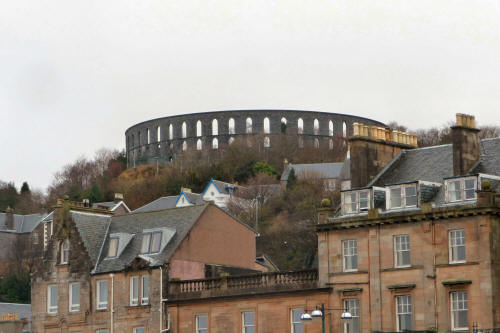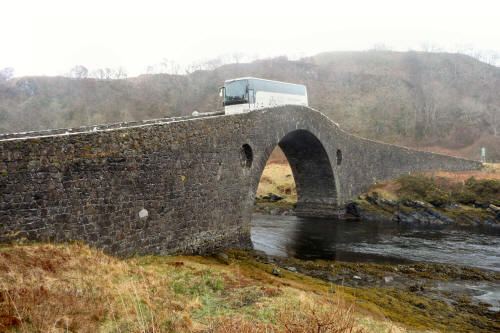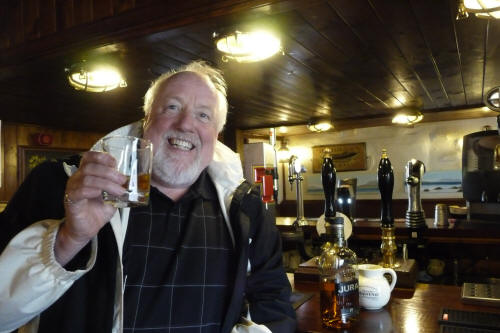Day Four
We got a bit of a lie-in today with
breakfast not being until 9:10 a.m. and the ferry across the loch an
hour later. I was able to use my laptop computer in the bar area early
this morning. The dining room staff at this hotel are excellent as are
the other staff. Everything runs smoothly. It is a very nice place to
be. The main entry lounge, where we all congregated to be called into
meals, has a fireplace with cozy crackling fire, sofas and wingback
chairs, but once the words “Breakfast for Kevin’s Party” are heard, the
lounge clears quickly. We kept the same seating in the dining room
throughout the trip. We were seated with one of the single travellers in
a bay window looking out across the loch toward Inveruglas.

Kevin pointed out the ruins of the McFarland
clan seat on a small island as we headed out today. There were a lot of
holiday chalets in this area. We learned that different mountain heights
have different names – i.e. anything over 3,000 ft. is a Munro, from
2,500 to 3,000 ft. is a Corbett, and the lower mountains are called a
Graham. We passed Tarbet Isle, which is known as the Honeymoon Isle.
Young couples who married were put on the island for a couple of weeks
to be sure they were going to get along! Loch Long, a long being a
Viking ship, is a sea loch. The Lochs and Glens hotel the Loch Long is
here. Near here also was the Bay Tarbet Hotel, which is a Shearings tour
company hotel.
We looked up at Ben Arthur, where
mountaineering started. The hills around here have tunnels in them for
munitions storage and are part of the MOD. The Ark Royal was docked here
before Christmas last year at the Glen Mullin Naval Base. There is a
former torpedo testing site in the area, now derelict. There are several
caravan and chalet holiday parks around here. Kevin pointed out where
the new Ardgarten Hotel is being built, and he told us there are eagles
in this area. He always sees them, he says. We suddenly see some very
large carved wooded eagles to the left of the coach! What a jokester!
Through Glen Crowe we can see the old military road with runs toward
Inverary to the Campbells.

It is very rocky scenery with large boulders
on the landscape. We pass through Rest and Be Thankful with its majestic
setting. I am watching the babbling burns, old stone bridges and fir
trees through the window. When trees are felled, the land is left to
rest and get sunshine for a couple of years before new trees in their
protective tubes are planted. We saw logging trucks on the roads, but
the continuous cutting, resting and replanting keeps the mountains full
of lush conifers. Large thick tufts of brown grass cover the open fields
and lower mountainsides in March. Once again I am seeing gushing
waterfalls, both long and short, some coming from the top of the
mountains in a zig-zag pattern to the lower slopes. I also have noticed
on this tour the abundance of moles in the pastures, the dark patches of
earth standing out against the light green of the spring grass.
We paused briefly at a well called Moses
Well in Hell’s Glen. The story goes that a group of gypsies bathed a
very sick local lad in the water, and he was cured. The locals accused
the gypsies of practicing witchcraft. The very dark patches of heather
are plentiful on the mountains here, and I try hard to picture the
purple of August. What a sight it must be! When we reach Loch Fyne, we
can see the baronial castle of the Duke of Argyll, built in the 1750s,
across the loch. Jim remembers his grandfather being invited to visit
the Duke back in the 1950s and 60s, but as a child the significance of
his grandfather’s prominence meant nothing to him. He knew his
grandfather was very well-known and always appeared at the Cowal
Highland Games each year, but his grandfather was just his grandfather
to him.
Kevin explained that the Duke of Argyll is
from the youngest son branch of the Campbells. Far back in history, the
youngest son married into the Bruce family and supported the cause of
Robert the Bruce. The youngest son branch then became the favored branch
and were promoted accordingly. The Stracher Campbells were the eldest
son branch and still claim to be the chief of the clan, although the
Duke of Argyll carries that title.
To Jim, Loch Fyne means herring kippers. I
had told him he brought our tour group to Inveraray in 2000, but he
didn’t remember it. He said he usually takes his groups to Fort William.
We had a Campbell couple on the tour, and he brought them here so they
could walk up to the castle. My cousin and I sat on a bench overlooking
the water while my aunt sat having tea in the restaurant above the
woollen mill. Today the coach parked at the woollen mill and we walked
off through the town, not a very large town, and spent some time in the
tourist information centre to ask if there is anything in town with
history of the Argyll and Southern Highlanders. If so, we know there
must be photos of Jim’s grandfather. Jim had hoped to visit the castle
to see what they have, but the castle doesn’t open for tours until
April. The museum holding the history of the Argyll and Southern
Highlanders is at Stirling Castle, so we will have to wait to search for
news of his grandfather’s exploits.

We went to the George Hotel for our lunch,
sitting beside a warm fire in a room full of old character. I had
spaghetti and Jim had Tarbet Potted Crab, which he said was wonderful!
We stopped in the sweet shop to buy Kevin some American hard gums, me,
an American, having to ask what they were - gumdrops. He was working on
the coach when we returned. I told him I had to ask what they were. He
said with a cheeky smile, “Do you have some?” I handed him the bag but
told him Jim had already been into them so there weren’t as many as I
had bought! Hamish had been up to his sneaky deeds again!
The sun had come out by the time we left
Inveraray. A famous writer from Inveraray, Neil Munro (1863-1930), was
not a favourite of the Duke of Argyll. When Munro died, the locals
wanted to build a monument to him. The Duke refused to have it on Argyll
land, so the monument is built on the first patch of land that is not
Argyll but is Glen Orchy Campbell land in Glen Aray. One biography I
read said Munro was the illegitimate son of a kitchen maid and a higher
up Argyll. Perhaps this is why the Duke wanted nothing to do with him???
We stopped to photograph Kilchurn Castle ruins, a former Glen Orchy
Campbell seat, which have been ruins since the 1700s. We got a glimpse
of the Loch Awe Hotel, another Lochs and Glens hotel, before arriving at
Dalmally, which was the home of former Labor leader, John Smith, who is
buried on Iona.

We passed through Tyndrum and the area of
churning burns, some with white rapids. It was so sunny and lovely. We
thought some snow had melted from the peaks during the day. The loch was
a bit rough but the sun allowed a wonderful photo of the hotel as we
approached on our ferry. Jim and I shared a bottle of cava in our room
before going down to an early dinner. The sunset across the loch was
fabulous tonight, pinks, pale oranges, and yellows. Jim sent me to the
room for the camera. A ceilidh singer, Gary Speirs, entertained early
this evening with his guitar then bodhran before the single male
singer/keyboard player came on for the dancing. At the intermission, we
were the party poopers who trekked off to our room and to bed.
